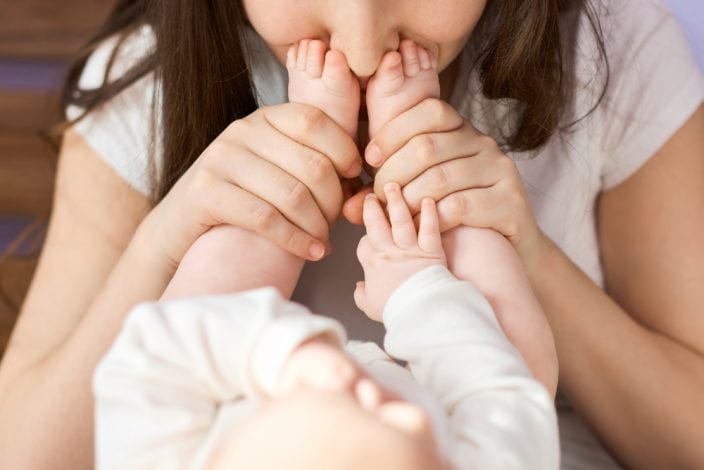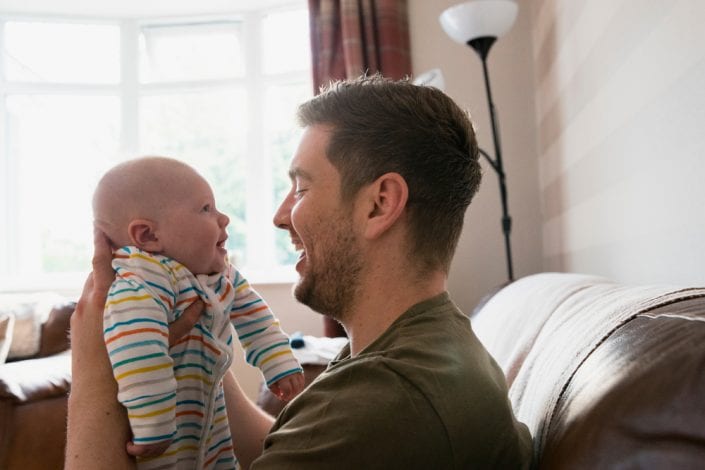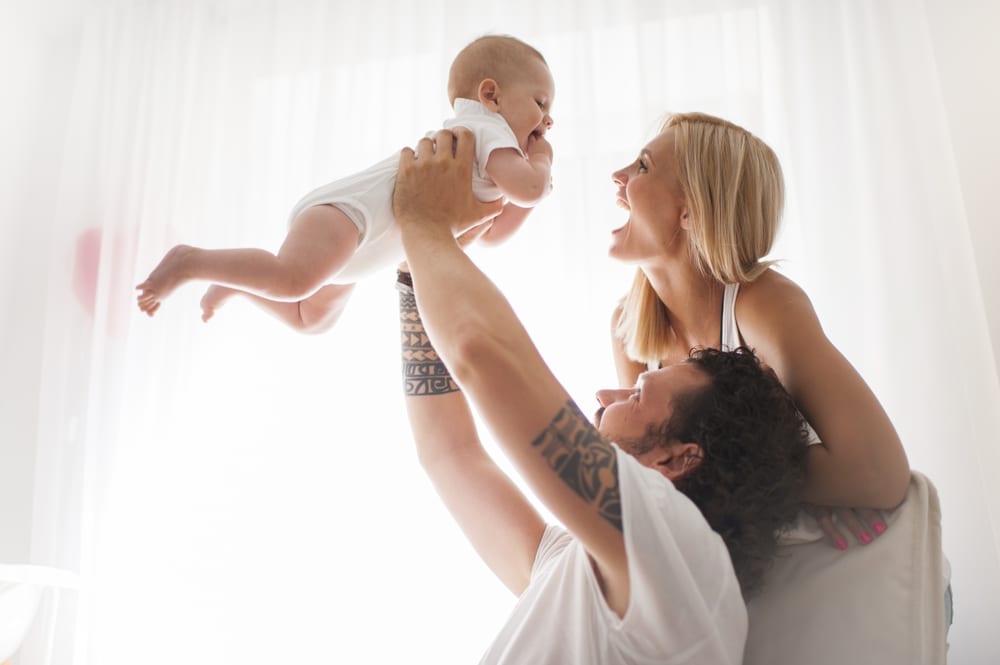How do you play with newborn babies? It might appear that newborns spend most of their time sleeping and feeding, but in the first few weeks babies’ bodies and minds develop at an amazing rate.
Your newborn is learning so many new things every day as they explore all the new sights, smells and sounds of the new world around them.
When it comes to providing stimulation for newborn babies, you don’t need to rush to enrol them in expensive baby classes or start holding up phonics flashcards in front of their faces.
Just by talking to and playing with newborn baby, you can help them along as they develop all their senses and discover the way their bodies move and work.
We’ve put together a list of 12 fun games you can play with newborn baby that you can start today. They’re can help baby develop those first developmental skills and they give you plenty of baby bonding time too!
Within this list we have included links to baby products that we recommend, some of which are affiliate links. If you click them to make a purchase, Mas & Pas will earn a commission at no additional cost to you. It also means that a big thank you is in order for supporting us!

Games to develop motor skills
At birth your baby will struggle to control their own movements but they will gradually develop their gross motor skills.
Baby’s muscles will slowly strengthen over time. They will start to lift their heads slightly, as well as making deliberate arm and leg movements.
A little tummy time
When your baby is awake and alert, place them on a safe, flat surface, on their tummy for just a few minutes at a time, a few times each day.
You could lie next to them to encourage them to turn and lift their head. You could put some bright toys near them so that they can look at and try to reach for them.
It’s also a nice idea to put them down on different textures for them to explore.
These can be blankets or play mats with different fabrics, or when they’re older, on the grass in the garden on a nice day.
If you are looking for a baby mat for baby, there’s a great selection out there to choose from. We love the Tiny Love Meadow mat as it’s a large mat with crinkly, shiny, fun features for baby to explore.
Lying on their tummies can be quite hard work for baby, so keep it short and sweet. Even 1-2 minutes is enough to help strengthen the muscles. Over the months you can build it up slowly to longer periods of time.
Every gross motor skill your baby will learn over the first few months will be the result of time spent playing on the floor.
From there he will learn to lift his head, to roll, to sit and to crawl. So a bit of tummy time is it’s time well spent.
Face to face
Lie down or sit in a reclined arm chair and place your baby on your chest so that you are face to face.
This will encourage him to lift his head to see you and is also a great way to talk to or sing to your baby as he gazes at your face.
You can share beautiful moments together while you play with baby.
Clap clap baby
If baby finds it too tiring lying on your chest you can sit with your knees lifted up (with your heels near your bum) to make a little seat for baby in your lap.
With baby leaning against your thighs, you’re face to face with them and you can sing them songs. Hold baby’s hands in yours and clap them together as you sing, or do other hand movements.
Don’t worry if you’re no Adele, your baby will enjoy the tunes no matter what.
‘Wind the bobbin up’ is a great song to sing with baby as it has so many hand actions to go along with it, but try a few and your baby will let soon you know their favourite!
The baby boogie
Babies love being moved around in your arms and they love the sway and rhythm as you dance with them.
Gently swoosh them around, rock them or boogie their arms about to your favourite song.
Games to stimulate the senses
Your baby’s new world is full of all sorts of new sounds, sights, smells and textures.
Help baby discover and explore them and develop their senses.

Mobile fun
Hang a mobile above your baby’s crib for their ‘playtimes’. At first babies can see black and white colours the best, so a mobile with just some black and white graphics can be fascinating for them.
We love Wimmer-Ferguson mobiles which have changeable graphic cards for baby, in particular their travel toy mobile that works on prams too.
By two months of age they will also be able to see bright colours. They will be able to pick out red and green, and very soon after blue and yellow.
A colourful mobile can provide great visual stimulation as your baby watches its movements, shapes and colours.
One of our favourites are the Tiny Love Soothe ‘n Groove mobiles. The animals rotate slowly but each one also does its own individual twist and performs a 180 degree turn as it goes round. From about 8 weeks onwards, little ones can get very excited watching them! Again there are a great selection of mobiles out there to choose from if you would like one.
If you do choose quite a loud and colourful mobile for over their crib, it might be a good idea to detach it and put it away at sleep time. The stimulation from the bright colours might keep baby awake and tire them out.
Tickle time
Babies love games where you gently stroke and tickle their skin or when you touch them. There are so many ways you can play with baby to touch their skin and make them giggle.
When she is lying on a mat smile at her and touch her hands, her feet, and kiss her tummy. See how she wiggles and reacts to your touch and your voice.
If you use words such as ‘beep’ before you touch their nose or feet, they will begin to anticipate the word and the game and love it even more. You can also use soft tissues, feathers or other fluffy items to tickle and touch your baby.
Shake, rattle and roll
Play with your baby, showing them noisy toys and objects, which you can shake and rattle to let them hear all the different sounds.
You can use noisy toys or even just pop rice in a box and shake it about for them.
All the feels
Let your child touch and feel lots of different objects with all sorts of different textures. Try toys and books with crinkly surfaces and objects with rough surfaces or raised patterns.
Squidgy toys and household items are also wonderful for them to touch and explore.
You can even take a light muslin and gently wave it over their face, and off again in one movement. Never leave a muslin on a baby’s face, but the gentle feeling of soft fabric brushing over their face is a great sensory activity.
Mirror, mirror on the wall
Babies LOVE to look at themselves in the mirror.
They’re fascinated with other babies and at first they will think that their reflection is a new baby friend who has come to play.
Show your baby their face in the mirror. Try pulling lots of funny faces or sticking out your tongue slowly in the mirror to make it a fun game for baby.
Or you can point and say their name and gradually your baby will begin to associate the face in the mirror with the sound.
Babies prefer looking at faces above all else and will soon begin to distinguish between the faces of those they know and those they don’t know.
Games to encourage communication
Parents and adults naturally speak to babies in a special voice, which is higher in pitch and has a more sing-song quality.
There’s actually a word for it and it’s known as ‘motherese’.
The more often you talk to your baby, the more they learn about communication and the better their language will develop.
Talking to baby can have an impact right from the first days and long before they can talk back.
When you leave pauses in your conversations with a baby, they soon learn that the pause is a signal that it is their turn to ‘talk’. As they get older, they’ll fill in the gaps with their own little noises or expressions.
Here are some ideas of how you can get talking with baby every day:

Think out loud
Talk to your baby as you go about your day. Explain what you are doing as you get them dressed and ready. Chat to them about the things you can see out of the window.
Explain to them that you are chopping the vegetables for dinner tonight. You might feel a bit silly at first, talking to such a tiny human who can’t speak back but, believe us, they are listening and learning.
Talking to your child is also one of the best things you can do to encourage their language development. Research has shown how important it is and how much of a different it can make:
The greater the number of words children heard from their parents or caregivers before they were 3, the higher their IQ and the better they did in school NY Times
So keep on talking.
Copycats
Imitating your baby is a great way to teach him about communication. Copy the expressions he makes and the things he does.
In playing this game with your baby, you are teaching him about the back and forth of communication and how we take turns when we talk.
And it’s great fun too, to take the lead from your baby and to see how he responds when you copy him. You will soon notice that he is trying to copy you too.
When he’s calm and awake and looking right at you, try pulling a facial expression very slowly. It could be as simple as doing an ‘ooo’ or ‘aaa’ in slow motion.
Can you see him trying to pull the same face afterwards?
Curl up with a book
Even teeny tiny newborns will enjoy hearing your voice and listening to stories.
Newborns also love to look at black and white pictures in their storybooks. After a few weeks they start to like bright pictures and colours when you read to them. Choose chunky books with fun storylines and rhymes and don’t worry if you’re reading the same ones over and over.
You can snuggle up together and your baby will enjoy listening to his favourite sound in the world – your voice.
Don’t stress about play time
The first three months with a newborn can be as exhausting and tough as they are beautiful and magical.
While you get to grips with feeding, changing and soothing your baby, you may often find the days passing without realising where they’ve gone. Don’t worry if you haven’t had the time or energy to play with him.
The amazing things you do each day, like cuddling, smiling at him, talking to him and rocking him, all help him thrive and develop.
Play time at this stage is all about the little moments that you share together. He will be learning so much from being close to you, from gazing at your face and from hearing your voice.
Very soon your baby will start to smile when he sees you and reach his little arms out for you. As he starts communicating back, you can both share all the more fun, games and giggles.


